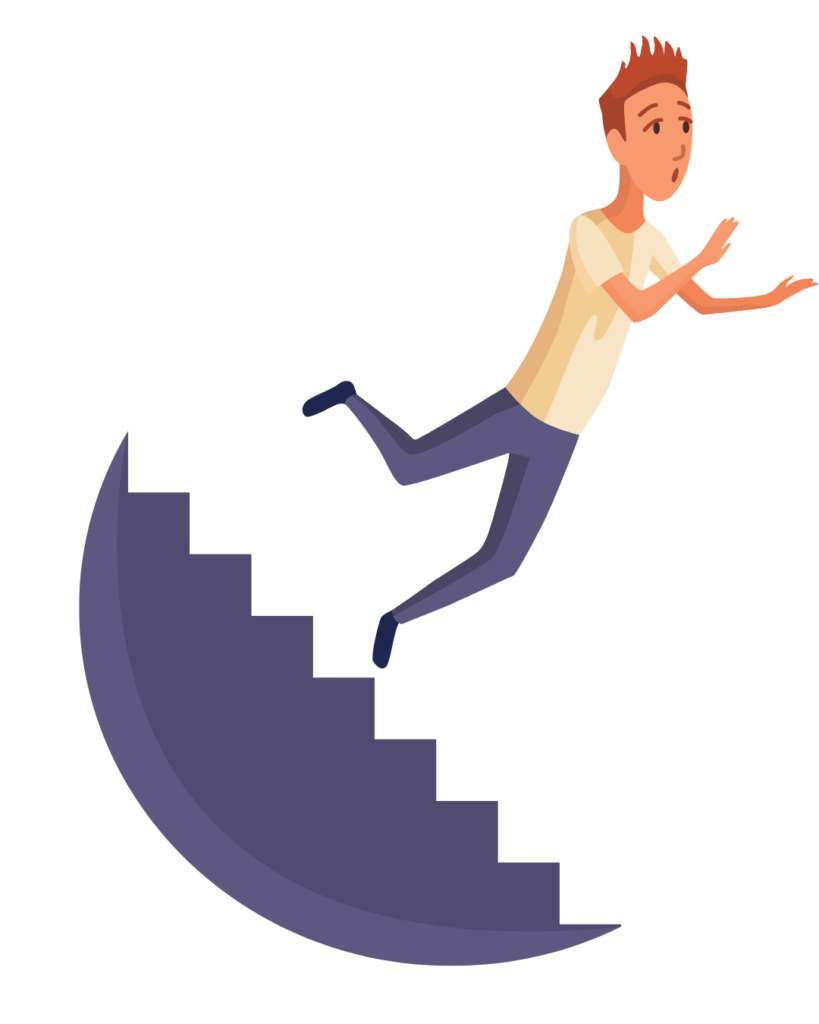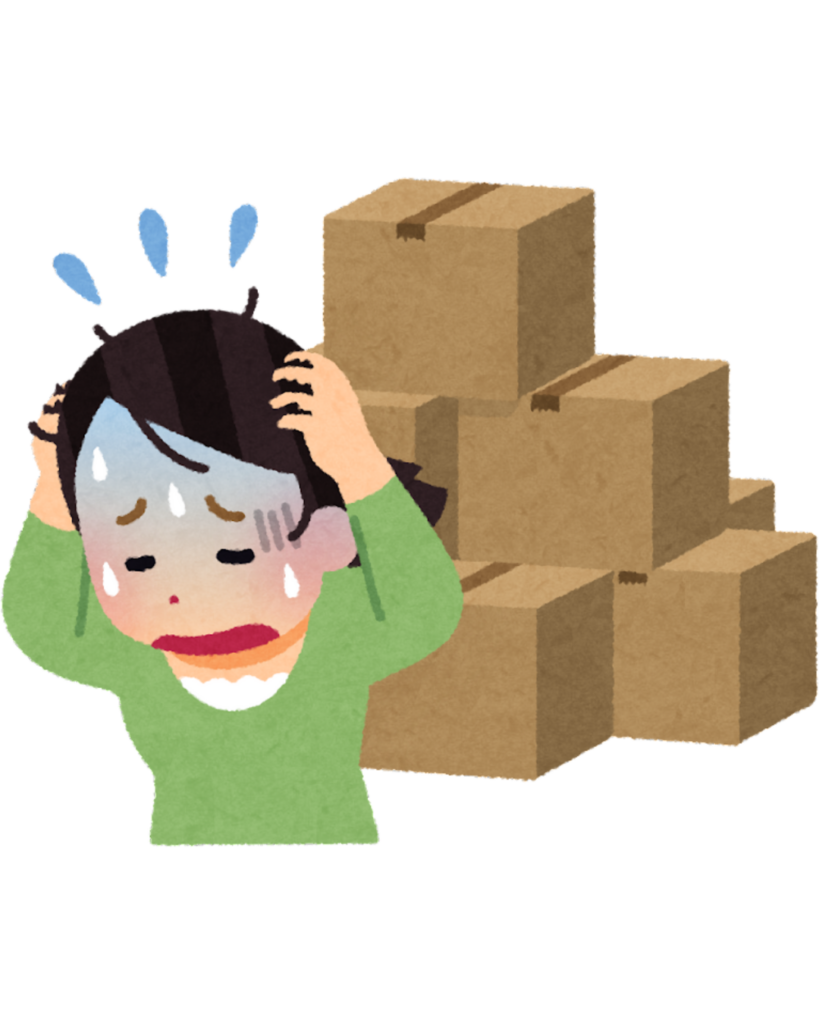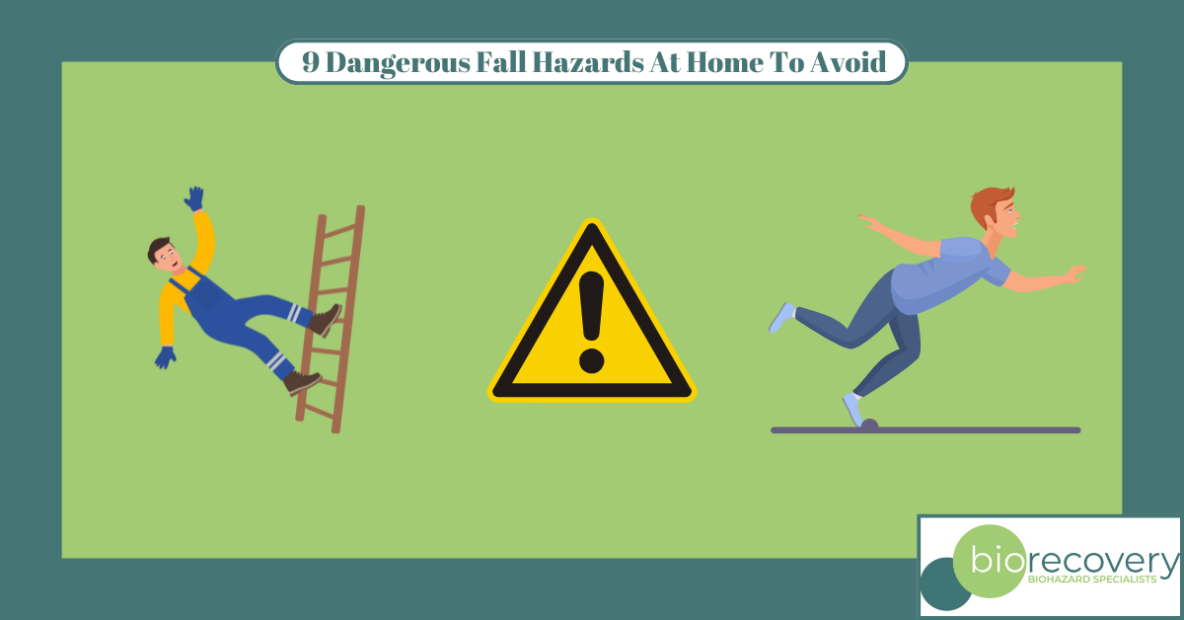At Bio Recovery we have done many death cleanup jobs and you would be surprised how many times the cause of death was due to a fall. This is especially true when it comes to senior citizens. That is why we are going to to cover 8 common fall hazards at home highlighted by the CDC
Every second of every day in the United States an older adult falls, making falls the number one cause of injuries and deaths from injury among older Americans. —Centers for Disease Control and Prevention (CDC)
Senior citizens, due to decreasing physical strength, coordination, balance, and eyesight, are more susceptible to falling, but younger adults and kids also benefit from going through their homes with a safety checklist published by the CDC to identify and address common household hazards.
9 Fall Hazards At Home
Regardless of age, falls at home can cause broken bones, traumatic brain injuries and, especially for seniors, lack of confidence in continued physical and social activity which leads to a further decline in poor health, agility, and cognitive function, increasing the odds of future injury. When a person aged 65 or older falls once, their chance of falling again doubles.
The CDC warns, “Most falls are caused by a combination of risk factors. The more risk factors a person has, the greater their chances of falling.” Here are some of the top hazards involved in injuries at home.
1. Steep, narrow stairways with uneven, slick or loose treads

Whether stairs are carpeted, concrete or treated wood, stairs can be a hazard.
“I was 42 when I slipped on our basement stairs. I was wearing socks, and my feet just went out from underneath me. I conked my head, and got a major bruise on my hip; I can only imagine how much damage I’d have suffered if I were older, with less bone density,” said Carolyn B, who added that she wasn’t under the influence of any medication or alcohol at the time.
“We thought it was a freak accident, but two years later my mom was looking after our cats while we were out of town. She slipped and fell, knocked herself out, and when she recovered, a broken leg kept her from being able to seek help.”
She wasn’t discovered until Carolyn and her husband returned to find her dehydrated, in a great deal of pain, but alive.
Many seniors use mobility aids such as walkers and canes which, on stairways, can actually increase the risk of falling. In some cases, seniors move to single-level dwellings or street-level apartments as part of their plan to extend their independence, while others opt to invest in stair lifts, which at an average of $4,400 to purchase and install, are often more affordable than hiring a moving company and the other financial and emotional costs associated with relocation.
2. Banisters and handrails improperly to walls
How wobbly are stairway banisters and railings? Are they properly attached to studs, and firmly attached to the floor? As we age, we increase our reliance on these safety features, possibly causing them to weaken. All handrails and banisters should be checked regularly for stability.
3. Showers and bathtubs
Handrails also help seniors maneuver in the bathroom. The New York Times reported on another CDC study that “The most hazardous activities for all ages are bathing, showering and getting out of the tub or shower.” and that 2.2 percent of injuries occur while entering the tub or shower, with 9.8 percent occur while getting out.)”
4. Flooring surfaces
Install double-stick tape on the underside of area rugs and mats, or at the very least, a rubberized underlayment. Consider installing well padded, low-pile carpeting on tile or slick wood floors.
5. Clutter

Does furniture arrangement block clear access throughout the home? As we age, it’s important to keep clear, wide pathways through rooms and halls.
“Often, seniors receive packages and need help getting them from one area of the home to the other, or have trouble carrying bulky items, so they sit at the bottoms of stairways until a more able-bodied friend or relative can help properly put them away,” said New York physical therapist Andrew M. “I have clients I see on a weekly basis, and I try make extra time to help with this kind of stuff.”
6. Ladders and step stools
Ladders and stepstools need to be sturdy, correctly opened, used on even surfaces and—whenever possible—used only when help is nearby or actively helping to steady the equipment.
More than 90,000 people receive emergency room treatment for ladder-related injuries every year, and most of these involve the user carrying or lifting an item, according to the Consumer Product Safety Commission (CPSC).
Many construction firms specializing in aging-in-place home retrofits recommend lowering upper cabinets and increasing storage space below waist level.
7. Improper footwear
Inexpensive slippers, improperly-fitted shoes and bare or socked feet reduce traction or inhibit agility, especially in seniors. Foot pain or swelling can also hinder one’s ability to gauge proper foot placement.
8. Medications
We all know that certain medications cause dizziness, impairment of judgment and coordination issues, and it’s important to be open and honest with health care providers about experiencing these symptoms and avoiding complications leading to falls. Blood thinners, commonly used with seniors, increase the risk of internal and brain bleeding, even if the fall itself doesn’t seem serious.
9. Decrease in fitness and coordination
The CDC recommends Tai Chi as an excellent tool for improving balance. Seniors or persons recovering from injuries can practice these low-impact exercises at home or at group classes. Many senior centers now offer Tai Chi as a result of studies that indicate its positive effects on the overall well-being of the elderly.
“Tai chi can not only reduce stress and depression, but also relieve pain, build strength, and improve cognitive function, perhaps even delaying dementia” says Peter M. Wayne, Ph.D., as quoted from Senior Planet. Dr. Wayne is Director of Research at the Osher Center for Integrative Medicine, jointly based at the Harvard Medical School and Brigham and Women’s Hospital in Boston.
This list is by no means comprehensive and doesn’t include another important fact: Our society and aging “baby boomer” generation means that more seniors are living independently, without close family nearby to look after them. Even those lucky enough to have loved ones or friends checking in on a daily basis can suffer falls or fatal injuries.
Steps to Avoid These Fall Hazards at Home
Anyone who lives alone should take safety measures to increase the chances that they will receive help if an accident occurs.
- Keep at least one telephone, even if it’s a spare cell phone (laws require all cell phones, even those not activated with a network plan, be able to connect to 911) charged and in reach of the floor.
- Subscribe to an emergency system that connects to emergency services
- Communicate with your doctor about previous falls, dizziness, headaches, or lack of coordination, and disclose all prescription and over-the-counter medication and supplements.
- Make arrangements with a friend, neighbor or family member to check in on a regular basis.
- See an eye doctor on a regular basis, and let them know if you have experienced vision problems, dizziness or headaches.
- Asking for help increases your chances for independence. Many people are afraid to be a burden, and don’t want to “put anyone out”, but when we allow people to help us once in a while, we’re ensuring our own safety. Be specific when asking for assistance with a task. You might be surprised to find out how eager your friends or family are to help.
Small accidents can have catastrophic effects.
“All too often, we’re called to unattended death cases in which a simple trip or fall ended a life,” says James Michel, Senior Estimator of Bio Recovery, a New York-based company that handles cleanup of human remains left undiscovered for days, weeks or even months, as well as blood and fluids resulting in any situation in which trauma is involved.
“These aren’t always isolated people. Last summer we had one gentleman who tripped and fell on his way out the door to a meeting at the Elks Lodge, and his buddies just figured his plans had changed when he failed to show up.” In this case, the man wasn’t discovered for nearly two weeks.
Look around your home and see if you can identify ten potential falling hazards. Then reach out to a senior in your life (whether or not you, yourself are in your golden years) and help them identify and remediate the issues that can limit their safety and independence. If you feel you don’t have someone to help you with solutions, reach out to local civic organizations. If you need assistance affording important retrofits, there are resources available.
Aging in place in a safe, well-equipped, retrofitted home can be less expensive than moving to an assisted living facility. Conducting a comprehensive safety check is something you can do now, with little investment at all. Take the time to be cognizant of potential fall hazards at home to avoid serious and sometimes fatal injury.
